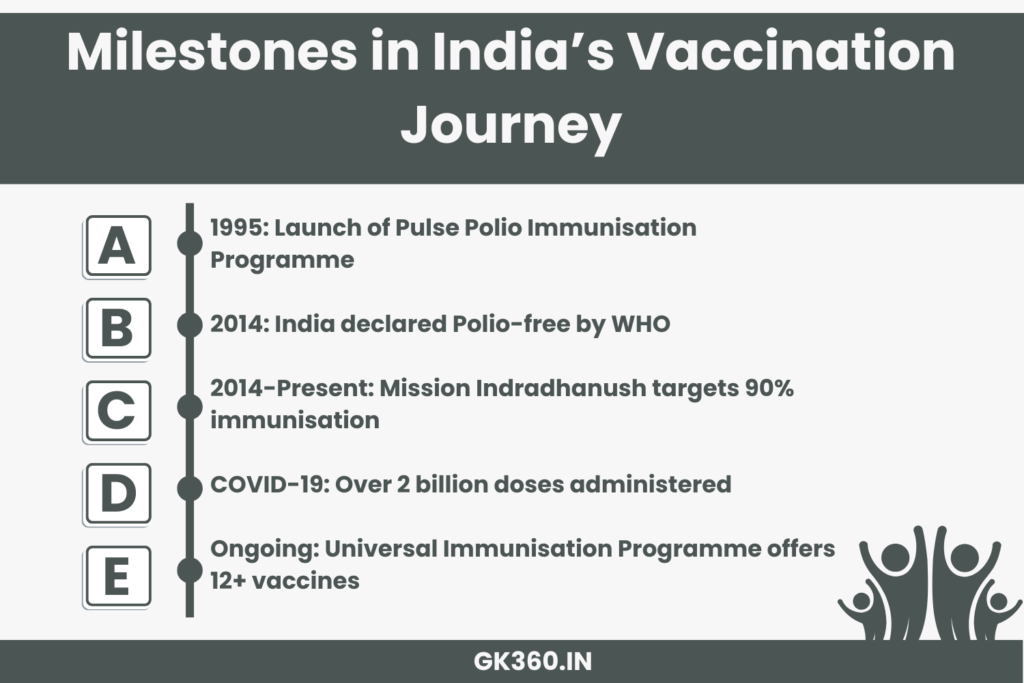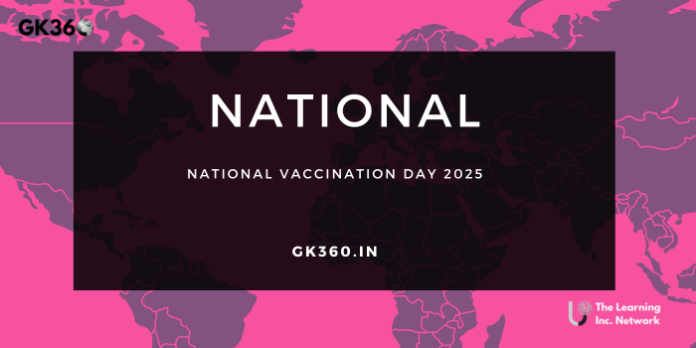National Vaccination Day 2025: India’s Immunisation Success and Public Health Mission
Introduction: National Vaccination Day 2025 at a Glance
Every year on March 16, India observes National Vaccination Day to reaffirm its unwavering commitment to public health through immunisation. The day marks a defining moment in the nation’s healthcare journey—commemorating the launch of the Pulse Polio Immunisation Programme in 1995, which laid the foundation for one of the world’s most successful vaccine campaigns.
As we mark National Vaccination Day 2025, it’s more than a celebration—it’s a tribute to India’s progress in disease prevention, healthcare innovation, and community-driven action. From eradicating polio to launching one of the fastest COVID-19 vaccine drives globally, India’s journey offers a powerful model for public health success.

“Infographic highlighting key vaccination milestones from polio eradication to the COVID-19 vaccination drive.”
Table of Contents
- Why National Vaccination Day Matters
- India’s Immunisation Milestones
- Key National Vaccination Programs
- The Role of Healthcare Workers
- Challenges in Vaccine Coverage
- Impact of Vaccination in India
- The Future of Immunisation in India
- FAQs on National Vaccination Day
- Conclusion and Call-to-Action
Why National Vaccination Day Matters
The Significance of March 16
March 16, 1995, was a landmark date in India’s healthcare timeline—the day the country administered its first dose of the oral polio vaccine under the Pulse Polio Programme. This campaign catalyzed India’s transformation from a polio-endemic nation to being certified polio-free by the WHO in 2014.
This day is now observed annually as National Vaccination Day, celebrating the collective determination of healthcare workers, policymakers, and communities to protect lives through vaccines.
A Day for Awareness and Action
More than a symbolic celebration, this observance serves three vital objectives:
- Promoting Vaccine Awareness: Educating the public about life-saving vaccines for diseases like measles, hepatitis, diphtheria, and tetanus.
- Recognizing Healthcare Heroes: Honoring doctors, nurses, and grassroots workers like ASHA and Anganwadi staff.
- Encouraging Community Engagement: Mobilizing citizens to participate in immunisation drives to build herd immunity and protect vulnerable populations.
India’s Immunisation Milestones
Polio Eradication
Before the mid-1990s, India accounted for a large proportion of global polio cases. The Pulse Polio Programme introduced mass, door-to-door campaigns backed by WHO, UNICEF, and the Indian government. By 2014, after two decades of tireless effort, India was declared polio-free—a milestone hailed globally as a public health triumph.
Measles and Rubella Campaign
In line with its commitment to eliminating vaccine-preventable diseases, India launched the Measles-Rubella (MR) vaccination campaign. Targeting over 400 million children, it significantly reduced child mortality and aligned with the country’s Sustainable Development Goals.
COVID-19 Vaccination Drive
India’s COVID-19 vaccination campaign began in early 2021 and quickly became one of the largest in the world. With homegrown vaccines like Covaxin and Covishield, and the strategic use of digital tools like CoWIN, India not only curbed the spread of the virus but also emerged as a global vaccine supplier through its Vaccine Maitri initiative.
Key National Vaccination Programs
Mission Indradhanush
Launched in 2014, Mission Indradhanush aims to achieve 90% immunisation coverage by targeting children and pregnant women in underserved areas. Special focus is given to marginalized communities, slums, and remote tribal regions through recurring Intensified Mission Indradhanush (IMI) rounds.
Universal Immunisation Programme (UIP)
One of the largest public health initiatives globally, India’s UIP provides free vaccines against 12 life-threatening diseases including:
- Diphtheria
- Pertussis
- Tetanus
- Measles
- Hepatitis B
- Pneumonia (Hib)
- Japanese Encephalitis (in endemic areas)
It has played a crucial role in reducing child mortality and improving maternal health outcomes.
The Role of Healthcare Workers
Behind every successful vaccination drive in India is an army of dedicated healthcare professionals who ensure that vaccines reach every corner of the country. Their work is especially crucial in rural, tribal, and remote regions where access is limited.
Key Contributors:
- ASHA workers (Accredited Social Health Activists): Community-based outreach agents who promote maternal and child health.
- Anganwadi workers: Vital in administering vaccines and maintaining immunisation records at the grassroots.
- Doctors, Nurses, and Paramedics: Trained professionals who lead immunisation delivery at public health centers.
- Mobile health teams: Crucial for reaching hilly terrains, flood-prone areas, and urban slums.
Their resilience was especially visible during the COVID-19 pandemic when these frontline workers risked their own lives to vaccinate millions, earning them global recognition.
Challenges in Vaccine Coverage
- Vaccine Hesitancy
Misinformation, myths, and fear continue to discourage people—especially in low-literacy rural areas—from getting vaccinated. Rumors about side effects or cultural taboos often derail public health efforts.
Solution: Nationwide awareness campaigns in regional languages and involvement of local influencers (teachers, religious leaders) to build trust.
- Limited Access in Remote Areas
Geographical barriers like mountains, forests, or flood-affected regions make vaccine delivery logistically difficult.
Solution: Deployment of mobile vaccination vans, boat clinics, and drone-based vaccine deliveries, which are currently being piloted in select states.
- Missed Booster Doses
Initial doses are often administered, but follow-ups—especially for children—can be missed due to migration, poor digital tracking, or lack of awareness.
Solution: Digital immunisation records (e.g., CoWIN integration with birth registries) and SMS reminders can improve compliance.
Impact of Vaccination in India
Public Health Achievements
- Polio Eradication: A 100% drop in cases since 2011.
- Neonatal Tetanus Elimination: Achieved ahead of global deadlines.
- MR Vaccination: Targeted 400+ million children to curb measles deaths.
Healthcare System Strengthening
- Cold chain logistics improved across states.
- Real-time vaccine tracking systems introduced.
- Integration of digital health IDs via Ayushman Bharat Digital Mission (ABDM).
Global Leadership
India has emerged as a vaccine diplomacy leader, exporting vaccines to 70+ countries and supporting the global COVAX alliance.
The Future of Immunisation in India
Innovations on the Horizon
- AI-powered vaccine forecasting to predict demand more accurately.
- Blockchain for supply chain transparency in vaccine storage and distribution.
- Biometric health records for vaccine tracking from infancy to adulthood.
Digital Integration
The CoWIN platform, originally built for COVID-19, is evolving into a national vaccination registry. This will improve follow-up doses, facilitate travel-linked certifications, and strengthen outbreak surveillance.
International Partnerships
- Cross-border disease tracking
- Emergency response coordination
- Joint vaccine development (e.g., for dengue or HPV)
FAQs on National Vaccination Day
What is National Vaccination Day?
It is celebrated on March 16 every year in India to promote immunisation awareness and honor the start of the Pulse Polio Programme in 1995.
Why is vaccination important for public health?
Vaccines prevent life-threatening diseases and reduce healthcare costs by avoiding hospitalization, disability, or long-term complications.
What programs support immunisation in India?
Key programs include Mission Indradhanush, the Universal Immunisation Programme (UIP), and state-led vaccination campaigns.
How did India eradicate polio?
Through large-scale, door-to-door vaccination efforts supported by WHO, UNICEF, and national agencies. India was declared polio-free in 2014.
How can people help boost vaccination awareness?
By getting vaccinated, educating others, supporting local health drives, and combating misinformation—especially on social media.
Conclusion and Call-to-Action
National Vaccination Day 2025 is not just a reflection of India’s past victories—it is a call to action for every citizen. From eliminating polio to managing the COVID-19 pandemic, India has shown what’s possible when science, policy, and people work together.
The road ahead requires sustained public participation, stronger digital tools, and unwavering support for frontline workers. As India advances toward universal vaccine coverage, every shot counts in building a healthier and more resilient nation.
Key Takeaways Table
| Aspect | Details |
| Significance of March 16 | Marks the first oral polio vaccine dose in 1995 under the Pulse Polio Programme. |
| Polio-Free Certification | India was declared polio-free by WHO in 2014 after two decades of efforts. |
| Major Immunisation Programs | Mission Indradhanush and Universal Immunisation Programme (UIP). |
| Role of Frontline Workers | ASHA, Anganwadi, and healthcare staff ensure nationwide vaccine access. |
| Vaccine Challenges | Include misinformation, inaccessibility in remote areas, and missed follow-ups. |
| Technological Innovations | AI, blockchain, and CoWIN enhancing efficiency and transparency. |
| India’s Global Contributions | Through Vaccine Maitri and participation in COVAX alliance. |





